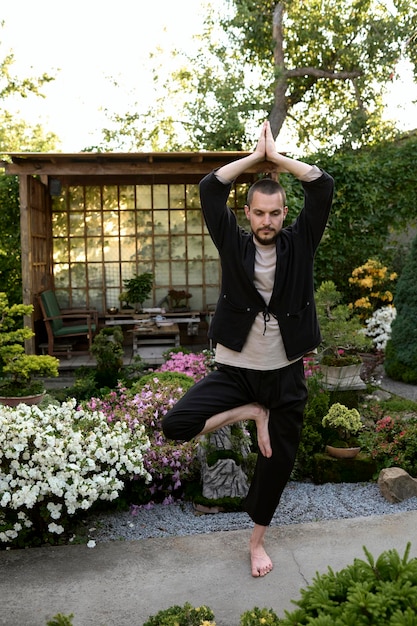Qigong Meditation: Enhance Energy Flow with Movement & Breath

Qigong meditation harmoniously combines gentle movements, focused breathing, and mental concentration to enhance energy flow and vitality, offering a holistic approach to well-being rooted in traditional Chinese medicine.
Unlock a path to enhanced vitality and inner peace with Qigong meditation, an ancient practice that seamlessly blends movement and breath to cultivate a balanced energy flow and boost overall well-being.
What is Qigong Meditation?
Qigong meditation is a practice that integrates physical postures, breathing techniques, and focused intention. Rooted in traditional Chinese medicine, it aims to harmonize the body’s energy, or Qi, to promote health and well-being.
Unlike static meditation forms, Qigong actively engages the body, creating a dynamic flow that can be both grounding and energizing.
The Three Pillars of Qigong
Qigong is built upon three essential elements that work synergistically to enhance vitality and balance.
- Movement: Gentle, flowing exercises that promote circulation and flexibility.
- Breath: Conscious breathing techniques to calm the mind and regulate energy flow.
- Mind: Focused intention and visualization to direct Qi and cultivate inner awareness.
These pillars aren’t separate but interconnected facets that enrich the experience and effectiveness of Qigong meditation.

Qigong meditation brings together movement, breath, and mental focus, creating a powerful synergy for enhancing energy and vitality.
Benefits of Qigong Meditation
Qigong meditation offers a diverse range of benefits that extend beyond stress reduction to encompass physical, mental, and emotional well-being. Regular practice can significantly improve your quality of life.
Many practitioners report improved sleep, reduced pain, and an overall sense of calm and increased energy.
Physical Benefits
- Improved Circulation: Gentle movements promote healthy blood flow, nourishing tissues and organs.
- Increased Flexibility: Qigong exercises stretch and lengthen muscles, enhancing range of motion.
- Pain Relief: Qigong can ease chronic pain conditions by promoting relaxation and reducing inflammation.
Mental and Emotional Benefits
- Stress Reduction: Focused breathing and gentle movements calm the nervous system.
- Improved Mood: Qigong can boost serotonin levels, promoting feelings of well-being.
- Enhanced Focus: Regular practice cultivates mindfulness and improves concentration.
From physical vitality to mental clarity, the benefits of Qigong meditation are far-reaching and often profound.
Getting Started with Qigong Meditation
Starting with Qigong meditation is easier than you might think. With a few basic guidelines, you can begin experiencing the benefits of this ancient practice in your own home.
Whether you’re a seasoned meditator or new to mindful movement, Qigong offers a gentle yet powerful path to well-being.
Finding a Qualified Instructor
While you can learn Qigong from books and videos, working with a qualified instructor can be invaluable. A good teacher can guide you through proper form, breathing techniques, and provide personalized feedback.
Look for instructors with certifications from reputable Qigong organizations and consider attending introductory workshops or classes.
Basic Qigong Exercises for Beginners
Here are two simple Qigong exercises you can try to get started:
- The Swaying Tree: Stand with your feet shoulder-width apart, knees slightly bent. Gently sway from side to side, imagining you are a tree in the wind. Focus on your breath and feel your body relaxing with each sway.
- Cloud Hands: Stand with your feet shoulder-width apart, knees slightly bent. Slowly raise one arm in front of you, as if reaching for a cloud, while the other arm lowers to your side. Alternate arms in a fluid, circular motion, focusing on your breath and feeling the energy flow through your body.
Starting slowly and focusing on proper form, anyone can begin to unlock the benefits of Qigong meditation.

Integrating Qigong into Your Daily Routine
One of the great things about Qigong is its adaptability. You can integrate it into your daily routine in various ways, whether you have just a few minutes or a dedicated hour.
Consistency is key, so finding a way to make Qigong a regular part of your life will yield the greatest benefits.
Morning Qigong for Energy
Starting your day with a short Qigong routine can set a positive tone and boost your energy levels. Even 5-10 minutes of gentle movements and focused breathing can make a significant difference.
Try incorporating exercises like “The Swaying Tree” or “Cloud Hands” to awaken your body and mind.
Qigong Breaks During the Day
If you work at a desk, taking short Qigong breaks throughout the day can help relieve tension and improve focus. Stand up, stretch, and practice a few mindful breaths to re-energize yourself.
- Try a simple standing meditation, focusing on your breath and body awareness.
- Gentle shoulder rolls and neck stretches can release tension in your upper body.
- Visualize energy flowing through your body, clearing any blockages or stagnation.
Evening Qigong for Relaxation
Practicing Qigong in the evening can help you unwind and prepare for a restful night’s sleep. Focus on gentle, calming movements and deep breathing exercises.
- Try a seated meditation, focusing on your breath and releasing any tension you may be holding.
- Visualize your body relaxing and releasing stress with each exhale.
- Create a peaceful environment with soft lighting and calming music.
By integrating Qigong into different parts of your day, you can experience its benefits throughout your life.
Different Styles of Qigong Meditation
Qigong meditation encompasses a wide variety of styles, each with its unique focus and approach. Exploring different styles can help you find one that resonates with your personal preferences and needs.
From gentle, therapeutic forms to more dynamic martial arts styles, there’s a Qigong practice for everyone.
Medical Qigong
Medical Qigong focuses on using Qigong techniques to treat specific health conditions. It often involves working with a trained practitioner who can assess your energy imbalances and develop a personalized treatment plan.
Medical Qigong can be used to address a wide range of ailments, from chronic pain and fatigue to digestive issues and emotional imbalances.
Martial Arts Qigong
Martial Arts Qigong is used to enhance physical strength, endurance, and coordination. It involves more vigorous movements and specific breathing techniques to develop internal power and focus.
- This style of Qigong is often integrated into martial arts training to improve performance and prevent injuries.
- Martial Arts Qigong can also be practiced as a standalone discipline for overall fitness and well-being.
Spiritual Qigong
Spiritual Qigong focuses on cultivating inner peace, spiritual awareness, and connection with the divine. It often involves meditation, visualization, and chanting to deepen your spiritual practice.
Spiritual Qigong can be practiced by people of all faiths and backgrounds who are seeking to enhance their spiritual growth.
No matter what your goals or interests, there’s a style of Qigong meditation that can help you achieve greater health, well-being, and inner peace.
Advanced Qigong Techniques and Practices
As you become more experienced with Qigong meditation, you may want to explore more advanced techniques and practices. These can help you deepen your practice and unlock even greater levels of energy, vitality, and awareness.
These advanced practices should be approached with patience, respect, and guidance from a qualified instructor.
Microcosmic Orbit Meditation
The Microcosmic Orbit is a central concept in Qigong and Taoist meditation. It involves circulating energy along two major energy pathways in the body: the Conception Vessel, which runs along the front of the body, and the Governing Vessel, which runs along the back.
This practice is believed to open and clear energy channels, enhance overall Qi circulation, and promote physical and emotional healing.
Bone Marrow Cleansing Qigong
Bone Marrow Cleansing Qigong is an advanced practice that aims to purify and strengthen the bone marrow. It involves specific movements, breathing techniques, and visualizations to stimulate the production of healthy blood cells and enhance the immune system.
This practice is believed to promote longevity, vitality, and resistance to disease.
Qigong with Sound Healing
Combining Qigong with sound healing can amplify the therapeutic effects of both modalities. Sound healing involves using various instruments, such as singing bowls, gongs, and tuning forks, to create vibrations that promote relaxation, balance, and healing.
The vibrations can help to release energy blockages, harmonize the nervous system, and deepen the meditative experience.
Exploring these advanced techniques can take your Qigong practice to new heights, allowing you to tap into your body’s innate healing potential and unlock deeper levels of awareness.
| Key Point | Brief Description |
|---|---|
| 🧘♀️ Gentle Movements | Enhance circulation and flexibility. |
| 💨 Conscious Breathing | Calms the mind and regulates Qi flow. |
| 🧠 Focused Intention | Directs Qi and cultivates inner awareness. |
| 🌟 Stress Reduction | Calms the nervous system promoting well-being. |
Qigong Meditation FAQs
▼
The main goal is to harmonize the body’s energy (Qi), promoting overall health and well-being. It combines movement, breath, and mental focus to balance internal energy.
▼
Consistency is key. Aim for at least 15-20 minutes daily to experience the full benefits. Even short, regular sessions can significantly improve energy flow and reduce stress.
▼
Yes, Qigong’s focus on breath and gentle movements can calm the nervous system, reducing anxiety and promoting relaxation. Regular practice can enhance emotional balance over time.
▼
No, special equipment is needed. Comfortable clothing and a quiet space are usually sufficient. Some may prefer to use a mat or cushion for seated meditations, but it’s optional.
▼
Yes, Qigong is generally suitable for all ages and fitness levels. The gentle nature of the movements makes it accessible to nearly everyone. It’s always wise to consult a healthcare provider before starting any new exercise regime.
Conclusion
Qigong meditation offers a transformative approach to health and well-being by unifying gentle movements, mindful breathing, and focused intention. Whether you seek to reduce stress, enhance energy flow, or deepen your spiritual practice, integrating Qigong into your life can unlock a path to greater vitality and inner peace.





